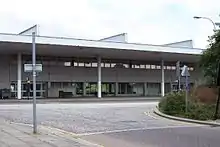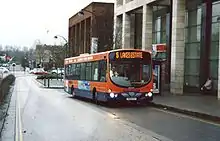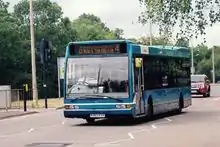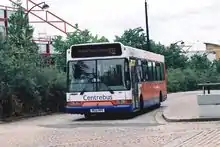Buses in Milton Keynes
Buses in Milton Keynes are run by a mixture of operators on a network of urban and rural routes in and around the Milton Keynes urban area. These services have a varied history involving five different companies. At the foundation of the 'New City' in 1967 and for some years afterwards, Milton Keynes was served by a rural bus service between and to the pre-existing towns. Apart from a small-scale experimental service, urban buses arrived on the scene with deregulation in 1986. Since April 2010 the core local services have been provided by Arriva Shires & Essex. Long-distance coach services also serve the city, often via the nearby Milton Keynes Coachway located near junction 14 of the M1 motorway.

Urban Services

Urban services in Milton Keynes have been operated by several companies under a wide range of names since the city's creation in 1967. Since 2010, the principal operator has been Arriva Shires & Essex, who acquired the independent MK Metro in 2006. The operation was initially branded as Arriva MK Star. The Arriva urban network has continually reduced in size since then and now consists of only the busiest key urban routes, with other areas being covered by Council contract routes or by other operators such as Uno and Stagecoach. A number of independent operators have begun providing services within the urban area where the Arriva network has contracted; principal among these are Aylesbury based Z&S Transport, Red Rose, Redline and Vale Travel.[1][2] Some of the longer distance routes detailed below also provide journeys within the urban area, such as Stagecoach routes 89, 40 and 52 and Centrebus route X31. Uno currently operate service C1 to Cranfield and Bedford in competition with Stagecoach service 52. Stagecoach also operate service 90 to Yardley Gobion via Old Stratford, taking over this from Centrebus in September 2014.
Bus services within Milton Keynes are complemented by a frequent train service between the major centres of Wolverton, Central Milton Keynes and Bletchley, operated by West Midlands Trains. A less frequent hourly train service also links Bletchley to Fenny Stratford, Bow Brickhill and Woburn Sands between Mondays and Saturdays.[3]
Long-distance services
A few long-distance services to Milton Keynes are operated by Arriva Shires & Essex, with others provided by Centrebus and Stagecoach East: these services interchange at the shopping centre and railway station. Other long-distance services run by National Express call at the Milton Keynes Coachway (where passengers may also interchange with east/west and London airports services), whilst Megabus services call at Kingston District Centre near the south-eastern edge of the urban area.
Arriva Shires & Essex

Arriva Shires & Essex run route 150 to Aylesbury at a frequency of up to half-hourly.[2] A pattern of operating a non-stop service 100 alongside a slower 150 via Leighton Buzzard began in February 2009; prior to then only route 100 had operated over the entire length of the route, with an hourly frequency.[4] Prior to September 2007 the route had been numbered X15; in the 1980s this had operated as a through service between Reading and Northampton, and was run jointly by Luton & District and Bee Line. It was shortened to terminate at Milton Keynes in 1986, and the Aylesbury – Reading section was abandoned in 1994 following Bee Line's withdrawal from the route.[5] In April 2013 service 100 ceased operating with service 150 returning to a route similar to the X15, due to a withdrawal of funds by Buckinghamshire County Council.[6]
Arriva Shires & Essex also operate the hourly route 70, which links Milton Keynes to Luton via Leighton Buzzard and Dunstable, and the hourly route 32 from Bletchley via Central Milton Keynes to Buckingham, which extends to Tingewick once a day.[2] Service X60 runs via Buckingham to Winslow and Aylesbury.[7] Arriva formerly operated local service 33 to Northampton, but this was taken over subsequently by Z&S and then by Red Rose.[8]
Stagecoach

Stagecoach operate four express routes, three local services and one school service into Milton Keynes. These are run by the Stagecoach in Bedford or Stagecoach in Northamptonshire divisions of what was previously United Counties Omnibus.
Route X5 links Oxford and Cambridge via Bicester, Buckingham, Milton Keynes, Bedford and St Neots with a half-hourly service seven days a week. It serves both Central Milton Keynes and the Milton Keynes Coachway for onward connections to north-south services. The route was launched in September 1995 and used the Cross Country brand. New Plaxton Panther coaches were introduced to the route in March 2009.[9]
Route X4, which is part of the Stagecoach Gold brand and was formerly branded as Cross Country, runs from Milton Keynes to Northampton, Wellingborough, Kettering, Corby and Peterborough.[2] It was introduced between Peterborough and Northampton in 2000,[10] with the extension to Milton Keynes introduced in 2004 to replace existing slower routes.[11] The service between Northampton and Milton Keynes became half-hourly with the extension of the Leicester-Northampton service X7 to Milton Keynes in October 2012, bringing direct links to Market Harborough, Brixworth and other areas of Leicestershire.[12]
Stagecoach also operate the 99 coach service linking Milton Keynes Central railway station with Luton railway station and Luton Airport. It was formerly named VT99 and used dedicated coaches in Virgin Trains livery.[13] However the route is now operated as a normal Stagecoach service.
In addition to the express routes, Stagecoach operates route 89 from Northampton to Central Milton Keynes via Blisworth, Towcester and Stony Stratford, route 40 to Bedford via Newport Pagnell and Bromham, route 52 to Bedford via Cranfield and Kempston and the schooldays only route 83 to Silverstone via Wolverton and Buckingham.
Milton Keynes Coachway

Milton Keynes Coachway is the second busiest coach station in the United Kingdom.[14] It is situated on the eastern edge of Milton Keynes close to junction 14 of the M1 motorway on the A509 road. There has been a coach interchange at the junction of the M1 since 1989.[15] The present (replacement) building opened in December 2010.[16]
Most north-south National Express services along the M1 stop here, as does the east-west X5 service between Oxford and Cambridge. The local 300 service (which also serves the adjacent park and ride) provides a link between the Coachway and Central MK (and the Central railway station for other bus, coach and train interchanges).
Milton Keynes central bus station

A central bus station for Milton Keynes was designed by Derek Yeadon of Milton Keynes Development Corporation and built in 1982/83 opposite Milton Keynes Central railway station.[17] On 4 August 2014, the design and construction of the building was recognised by being Grade II listed by the Department for Culture, Media and Sport on the advice of English Heritage.[17][18] The citation remarks
“The design of the bus station with its projecting canopy, exposed steel girders and lightweight supporting steel columns, draws on influential buildings by the acclaimed modernist architect Mies van der Rohe, whose ideology inspired the new town plan and its buildings. There is a sculptural quality to some of its internal features and the core building is detailed to an unusually high standard for its use.[17]
Since 1997, the building ceased to be used for its original purpose and the bus interchange is now in front of the railway station. The building was subsequently repurposed as a youth centre, and a skate park named the Buszy was built.[19] The youth centre was closed in 2016 when its operators ("Make a Difference") and the building owners (Milton Keynes Development Partnership, an arm's length agency of Milton Keynes Council[20]) failed to reach an agreement for its continuance.[21]
The skate park (the Buszy) is an important skate spot, attracting professional skateboarders from around the world[22] and has been featured in numerous skate videos. The park is free to use by all and remains in regular use. The Buszy's cultural importance and significance in UK skateboarding is substantial.[23] The skate park was designed by designer Richard Ferrington and professional skateboarder Rob Selley.[24] The facility has been identified as an exemplar for local authorities around the UK.[25]
As of December 2018, the upper part of the building is being used as a dance studio. The lower area of the building has been used to provide assistance to homeless people.
History
United Counties
From 1967 until 1986, services between the major centres in Milton Keynes were run by United Counties Omnibus. Depots in Bletchley and Stony Stratford were used until 1983, when they were replaced by a new depot in the city centre. The services were operated with a mixture of double-decker buses and some large single-deck vehicles according to the historical rural bus service model. Although they were relatively frequent and ran for most of the day, buses could not easily serve new developments as the roads were not wide enough. When it was designed, the city had been intended for every household to own a car. Bus priority schemes did not exist, and stops were often sited away from population centres, although no house was more than 400 metres from a stop. New services were often poorly used in their early years as development in each area of the city built up over time, and such routes required significant subsidies. This was partially offset by the low running costs encountered when running on the trunk roads around the city.[26]
One area in which operations were successful was fares. A zonal system was operated with five single fares. A multi-journey ticket named Quad was offered, offering four single journeys of any length at a lower cost, and by the early 1980s was the most popular ticket in the city. Around 60% of tickets were sold off-bus. Subsidies for loss-making services were provided by Buckinghamshire County Council and Milton Keynes Borough Council. In its later years, the operation traded under the Citybus name. A new depot and the central bus station were built in 1983 at a combined cost of £6.5 million.[26]
In 1986 United Counties was split into smaller divisions in readiness for deregulation, and Milton Keynes depot formed a new company, Milton Keynes Citybus.
Milton Keynes Dial-a-Bus
To deal with the impracticality of a conventional staged bus service in the low-density new districts, Milton Keynes Development Corporation decided in 1973 to adopt and adapt the American Dial-a-ride concept, initially in Woughton Parish. According to this system, users who needed transport could call a central dispatch office and have a nearby (radio-controlled) Mercedes-Benz mini-bus diverted to the caller's street. The service began in 1975.[27] Operation of the service was contracted to the incumbent operator, United Counties, which chose to operate it under its existing agreements with drivers. The service did not survive long.[28]
Milton Keynes Citybus
Milton Keynes Citybus (initially Milton Keynes City Bus) was formed in January 1986 to take over the Milton Keynes depot of United Counties. It was privatised on 7 August 1987[29] and introduced a policy of operating minibuses in an unusual two-tone grey livery. It took over a small independent, Johnson's of Hanslope, in 1990 and initially retained this as a separate operation. Other brandings introduced in 1992 were County Line and Buckinghamshire Road Car; all were run with a mixture of full-size vehicles and minibuses.[30]
In November 1992 Milton Keynes Citybus was taken over by Cambus Holdings. The three offshoots were merged under the Road Car name, and the operation was expanded at the expense of the main company. New liveries were also introduced in 1993, with Citybus becoming red and cream and Road Car green and white. The company was officially renamed MK Metro in 1994, but this was not used as a fleet name.[30]
MK Metro

Cambus Holdings Ltd was acquired by Stagecoach Group in late 1995. An investigation by the Office of Fair Trading (OFT) concluded that this had led to an unacceptable monopoly of bus operations in Cambridgeshire, Corby, East Northamptonshire, Kettering, Wellingborough, Bedford and Mid Bedfordshire.[31] Stagecoach was ordered to sell the Milton Keynes and Huntingdon operations to avoid the deal being referred to the Monopolies & Mergers Commission. The OFT also stipulated that both depots must be sold to the same buyer.[32]
Milton Keynes Citybus was purchased on 2 May 1997 by bus entrepreneur Julian Peddle, using a new Premier Buses Ltd company both to operate in Huntingdon and as a holding company with which to purchase Milton Keynes Citybus.[33] The Milton Keynes operation was rebranded as MK Metro with a bright yellow and blue livery. Peddle was unable to fund new vehicles for both companies, and sold Premier to Blazefield in 1998.[32]
In the nine years that MK Metro was owned by Peddle ridership increased by 120% and the company became profitable. Between 1998 and 2003 passenger numbers rose by 63% following the introduction of new buses and ticketing schemes.[34] It became part of his Status Bus & Coach mini-group – an attempt to co-ordinate the resources of small independents to save money – at its formation in 1999, but the group proved largely unsuccessful and had broken up by 2004.[32]
Arriva

In February 2006, the operations of MK Metro were purchased by Arriva for £5.6 million,[35] and operational control transferred to the Arriva Shires & Essex division. Peddle cited disagreement between authorities as a major factor in his decision to sell the company.[32][36] The purchase was considered by the Office of Fair Trading for possible referral to the Competition Commission, but it was decided not to do so.[37]
The Milton Keynes operation continued to use the MK Metro name until April 2010, when they were rebranded as Arriva Milton Keynes (temporarily using the brand name MK Star). The change of name coincided with a number of controversial service changes.[38] Some services were in fact improved in frequency as part of the rebranding but others were reduced or even eliminated, and some journey times were increased.[39]
Other Operators
Since deregulation in 1986 there have been some competing companies in Milton Keynes, although it has seen less competition than most cities. London-based R&I Tours began competing with Milton Keynes Citybus in 1992 using the trading name Inter MK. They operated 10 single-deck buses, mostly Leyland Nationals in a two-tone blue livery, on a small number of routes in the city.[40] They withdrew from the city in 1994[41] and were subsequently taken over by MTL.[42]

In November 2009 a new competing route 44 between Central Milton Keynes and Lakes Estate was launched by coach company On A Mission.[1] It was later extended across Milton Keynes to Wolverton, and also included a single school bus journey. However, the company collapsed on 2 August 2010 and the route no longer operates. The school bus journey was replaced by a tendered route.[43]
EasyBus
EasyBus, an intercity express coach operator founded by entrepreneur Stelios Haji-Ioannou, ran a service between Milton Keynes and London between August 2004 and February 2006 using 19-seat Mercedes-Benz Vario mini-coaches. Tickets were predominantly sold over the internet. Its parent EasyGroup first announced its intention to operate no frills express services in 2003. In August 2004 EasyBus launched its first service, connecting London and Milton Keynes.[44] To keep costs down EasyBus originally used Hendon Central station in north London as its terminal point, with a journey time of 65 minutes and a single fare of £5.[44] The threat of competition forced National Express to offer its own discounted fares to and from London, culminating in the introduction of a £1 single fare between Milton Keynes and London which Stelios claimed was intended to make his service non-profitable and force its withdrawal.[45]
In Spring 2005 EasyBus changed its London terminus from Hendon to a more central location in Baker Street. The service to Milton Keynes was withdrawn in February 2006, although services from London to other destinations including Luton Airport continue to operate.[46]
Virgin Trains
%252C_2_May_2009.jpg.webp)
In 1999, Stagecoach commenced operating route VT99 from Milton Keynes Central to Luton railway station and Luton Airport under contract to Virgin Trains West Coast, with coaches in a dedicated livery to provide a connection for West Coast Main Line passengers to the airport.[47] Although no longer carrying Virgin Trains branding, Stagecoach continues to operate the service as route 99 with vehicles in its own livery.[48]
Ticketing
In June 2012 Milton Keynes council introduced a new multi-operator ticket, MK Moove.[49] As of September 2013 it is valid on all services of nine participating operators within the borough, with the exception of Stagecoach's X5.[50]
References
- "Oxford and Chiltern Bus Page – Spottings & Jottings". Oxford-chiltern-bus-page.co.uk. 6 November 2009. Retrieved 26 June 2010.
- "Milton Keynes Bus Timetables". Miltonkeynes.com. Archived from the original on 8 June 2010. Retrieved 26 June 2010.
- Milton Keynes Central National Rail
- "Improvements to Aylesbury's bus network". The Bucks Herald. 16 February 2009. Retrieved 26 June 2010.
- "Oxford & Chiltern Bus Page – Weekly News Updates". Oxford-chiltern-bus-page.co.uk. 26 September 2007. Retrieved 26 June 2010.
- "Tom Walker". Facebook. Retrieved 10 February 2014.
- http://www.transportforbucks.net/Buses-and-trains/Proposed-changes-to-routes-60/X60-and-32/50.aspx Archived 11 August 2014 at the Wayback Machine Buckinghamshire County Council page on the changes to route 32.
- "Red Rose Travel | Red Rose Travel". www.redrosetravel.com. Retrieved 15 November 2017.
- Jolly, Stephen (April 2009). "Stagecoach X5: All things to all men, women and bicycles". Buses (649): 36–38.
- "Stagecoach United Counties Service Changes". Scbeastmidstravel.co.uk. 6 October 2002. Retrieved 26 June 2010.
- "Peterborough Bus Times – News 2004". Globestudios.co.uk. 19 December 2004. Retrieved 26 June 2010.
- "VT99 timetable – Stagecoach" (PDF). Luton.gov.uk. Archived from the original (PDF) on 5 July 2010. Retrieved 26 June 2010.
- "Building the new Milton Keynes Coach Station". Milton Keynes Council. Archived from the original on 30 November 2010. Retrieved 20 January 2010.
- "City wins new coach stop". Milton Keynes Citizen. 20 April 1989. p. 3.
- New Coachway to open on December 13 MK News 23 September 2010
- Duncan, Jessica (4 August 2014). "The former Milton Keynes bus station has been recognised by English Heritage". MKWeb. Archived from the original on 8 August 2014. Retrieved 4 August 2014.
- Historic England. "Former bus station, Station Square, Milton Keynes (1416117)". National Heritage List for England. Retrieved 2 October 2019.
- A Buszy Place Archived 8 August 2014 at the Wayback Machine – Neil Shefford for MKWeb, undated
- "MKDP: about us". Retrieved 7 March 2019.
- "Make a Difference/The Buszy". Milton Keynes Council. 7 October 2015. Retrieved 6 March 2019.
- "Interview with Matt Pritchard". Retrieved 2 October 2019.
- "Interview with Leo Sharp". Retrieved 2 October 2019.
- "History - mkskate.org". mkskate.org. Retrieved 2 October 2019.
- "Best practice don't repel the borders". Local Government Chronicle. 19 April 2006. Retrieved 16 February 2019.
- "Serving a new town: United Counties operations in Milton Keynes". Buses (341): 348–9. August 1983.
- "Milton Keynes: Timeline". MK-Web.com. Archived from the original on 8 June 2011. Retrieved 26 June 2010.
- Bendixson, Terrence; John Platt (1992). Milton Keynes: Image and Reality. Cambridge, England: Granta. p. 160. ISBN 978-0-906782-72-9. Retrieved 1 June 2010.
- Morris, Stephen (September 1996). "NBC since NBC: a history of the former NBC subsidiaries". Buses Focus: 47.
- Brown, Stewart J (November 1995). Buses in Britain 2: The Mid Nineties. Capital Transport. p. 181. ISBN 978-1-85414-181-1.
- "Stagecoach Holdings plc – and Cambus". Office of Fair Trading. 5 June 1996. Archived from the original on 18 October 2011. Retrieved 26 June 2010.
- Millar, Alan (March 2009). "What Julian Did Next". Buses (648): 30–35.
- "United Kingdom: Competition Law and Policy in 1997–1998" (PDF). OECD.org. p. 19, para 97. Retrieved 26 December 2007.
- "Ridership up at Milton Keynes Metro :: Bus and Coach Magazine". Busandcoach.com. 22 November 2003. Archived from the original on 24 February 2012. Retrieved 26 June 2010.
- "Arriva acquires MK Metro Ltd" (Press release). Arriva.co.uk. 13 February 2006. Archived from the original on 28 December 2007. Retrieved 24 December 2007.
- Smith, Doug (28 May 2008). "Milton Keynes bus service claims are 'utter rubbish'". Milton Keynes Citizen. Retrieved 26 June 2010.
- "Completed acquisition by Arriva plc of Premier Buses Limited". Office of Fair Reading. 1 June 2006. Archived from the original on 4 December 2008. Retrieved 24 December 2007.
- "Arriva Milton Keynes website". Arrivabus.co.uk. Retrieved 26 June 2010.
- "Changes to bus services could increase journey times". Milton Keynes Citizen. 15 April 2010. p. 31. Retrieved 26 June 2010.
- Brown, Stewart J (September 1993). Buses in Britain. Capital Transport. p. 136. ISBN 978-1-85414-158-3.
- McLachlan, Tom (1995). London Buses 1985–1995: Managing The Change. Venture Publications. pp. 94–97. ISBN 978-1-898432-74-6.
- Morris, Stephen (September 1996). "PTE to PTC: what happened to the Passenger Transport Executives". Buses Focus: 53.
- "Milton Keynes Council – Local Bus Service Tenders, August 2010". Milton Keynes City Council. 17 August 2010. Archived from the original on 18 July 2011. Retrieved 11 August 2010.
- "EasyBus confirm Milton Keynes start date :: Bus & Coach Magazine". Busandcoach.com. 6 August 2004. Archived from the original on 24 February 2012. Retrieved 26 June 2010.
- Reece, Damian (19 August 2004). "Stelios and National Express clash over EasyBus". Independent. Retrieved 26 June 2010.
- "Arriva to operate Stelios' EasyBus links :: Bus & Coach Magazine". Busandcoach.com. 14 February 2006. Archived from the original on 24 February 2012. Retrieved 26 June 2010.
- Virgin and Stagecoach launch new Rail Link bus services The Railway Magazine issue 1180 August 1999 page 75
- Route 99 timetable Stagecoach
- MK Moove – A new bus ticket for Milton Keynes Archived 7 November 2012 at the Wayback Machine Milton Keynes Council, 3 June 2012
- MK Moove – A Multi-Operator bus ticket for Milton Keynes Archived 10 September 2013 at Archive.today Milton Keynes Council. Retrieved 10 September 2013.
External links
- Route maps and Travel guide – Milton Keynes Council
![]() Media related to Buses in the Borough of Milton Keynes at Wikimedia Commons
Media related to Buses in the Borough of Milton Keynes at Wikimedia Commons

